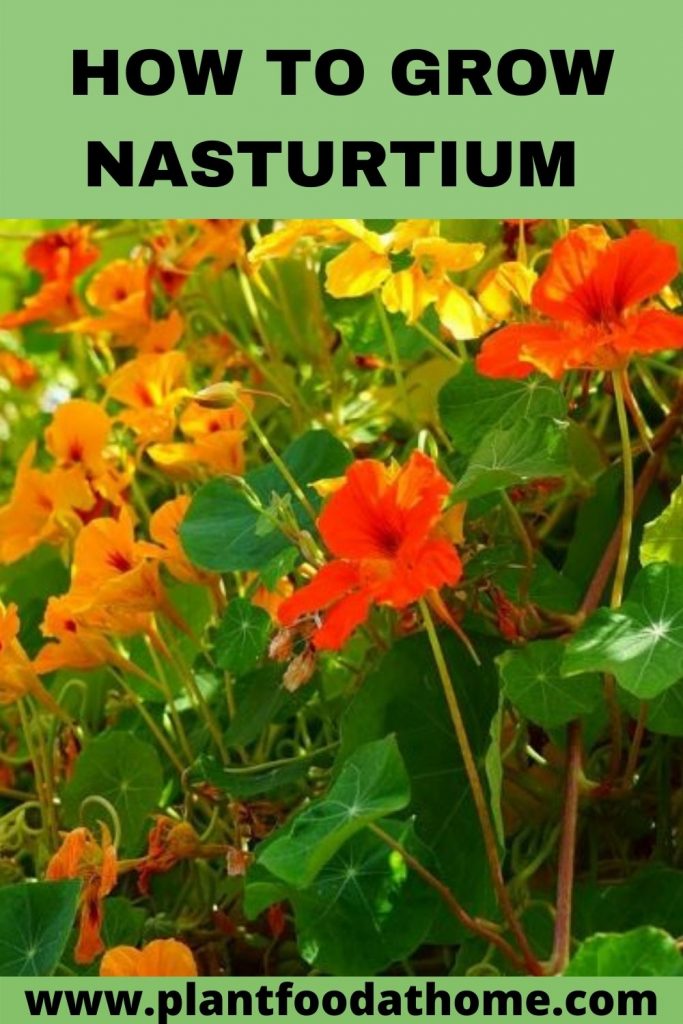Growing nasturtium in the vegetable garden not only looks great but also provides many benefits to the vegetable garden. Nasturtium is a wonderful companion plant, it attracts beneficial insects, nasturtium grows as an edible ground-cover and it’s entirely edible. So if you’re looking to grow this pretty flowering plant, you’ve come to the right place. Read on for how to grow nasturtium in the vegetable garden.
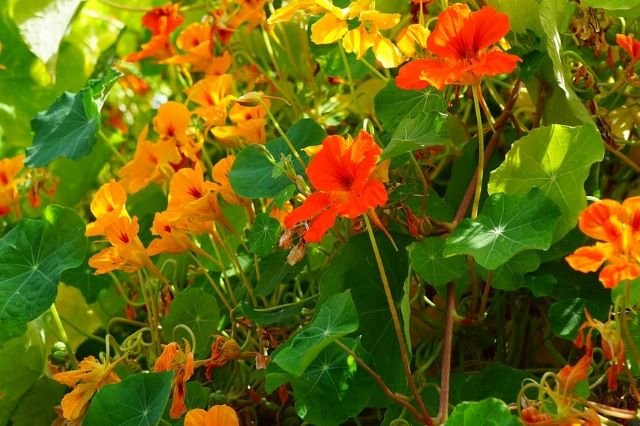
Table of Contents
What is Nasturtium
Nasturtium, (botanical name Tropaeolum) is a biannual flowering plant, often grown as an annual. With its origins in South America, the nasturtium plant is not only grown as an attractive flowering ornamental plant, but also a productive culinary herb plant.
And if you would like to know more about how to eat nasturtium, you can read in our article on how to use nasturtium in the kitchen.
Nasturtium has bright, colorful, trumpet-shaped flowers, with lush green leaves on a central stalk (known as the petiole).
The type of nasturtium are Trailing (Tropaeolum majus) and Bush (Tropaeolum minus). Trailing nasturtium normally climbs or spreads on the ground, while the Bush nasturtium grows in thick clumps.
Common Nasturtium Varieties
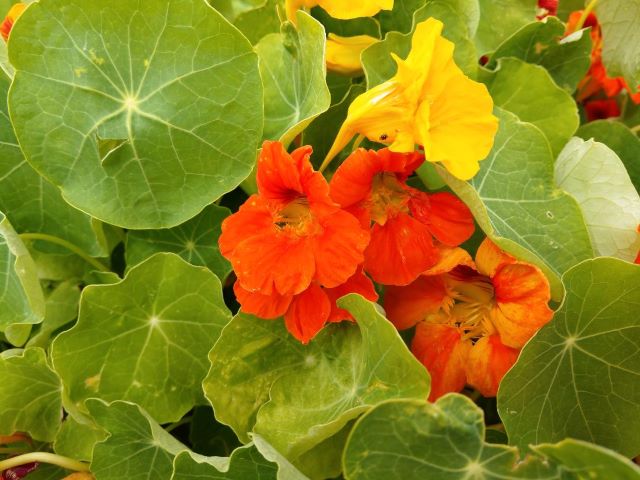
There are more than 50 varieties of nasturtium with some producing variegated leaves and others growing leaves up to 6 inches (15cm) diameter, practically a dinner plate. Some of the best-known nasturtium varieties are:
- Alaska – a bushy type that has variegated leaves of white and green, with flowers that are cherry, yellow, salmon and crimson colors.
- Apricot – a bushy type that has bright green leaves and apricot-colored flowers.
- Black Velvet – a trailing type that is adored for its deep red-colored flowers.
- Empress of India – a bushy type that has dark blue-green leaves with scarlet-colored flowers.
- Fiery Festival – a trailing variety that has bright green leaves and bright red flowers with yellow at the center.
- Indian Chief – a trailing type that has dark green leaves and bright red flowers with dark red at the center.
- Jewel Mix – a bushy variety with flowers in red, yellow, and apricot.
- Orange Gleam – a trailing type with scented flowers in bright-orange color.
- Orchid Flame – a bushy type and the flowers have two colors. It has golden yellow with bright red stains in the early season and changes to full red later on.
- Peach Melba – a bushy variety with light yellow-colored flowers and red at the center.
- Phoenix – a semi-trailing type with colorful red-orange flowers.
- Purple Emperor – a trailing type with deep green leaves and light purple flowers that turn to lavender.
- Vesuvius – a bushy type with blue-green leaves and salmon pink flowers.
- Whirlybird Mix –a bushy type with a variety of colors from yellow to tangerine to scarlet.
- Yeti – a trailing type with creamy white and yellow flowers.
All the varieties are beautiful, but it’s fun to buy nasturtium as a Jewel Mix which will give a variety of colors to grown in the one packet. And with each emerging seedling, you’ll be excited to see which nasturtium flowers next.
How to Grow Nasturtium
Nasturtium plants are one of the easiest plants to grow from seed. Plant the seeds in early spring and anytime during the year in a warm climate. Ideal soil temperature for seed germination is 64-77°F (18-25°C).
Soaking the seeds overnight in lukewarm water can help get a head start on the germination time, but it’s not required.
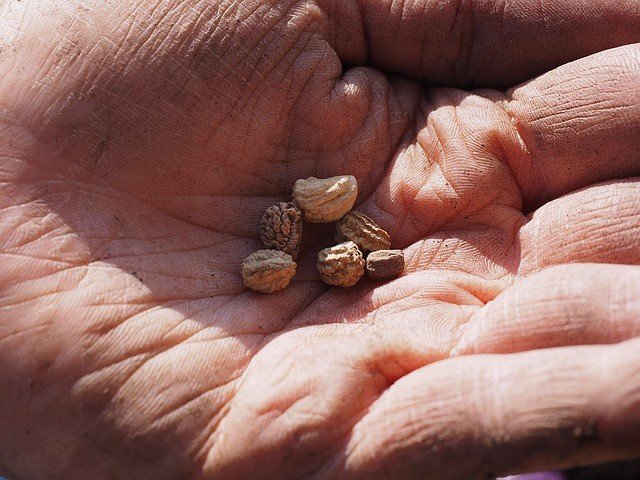
Nasturtiums don’t like to be transplanted, so it’s best to sow then directly in the ground or in the container. If you plan to transplant them later, I suggest using peat pots which can be planted in the garden later on without disturbing the roots of the seedlings. In this case, nasturtiums can be started indoors, to give them a head start on the growing season. Start them 4-6 weeks before the last frost date.
Plant nasturtium seeds to a depth twice the length of the seed or half an inch (1.5cm) and about 10 inches (25cm) apart. You should see the nasturtium emerge in 7-21 days.
Sun
Nasturtium plants grow best in full sun. They’ll also grow in partial shade, however, the plant will produce fewer flowers and more foliage.
Soil
Moderately fertile and free-draining soil will help your nasturtium thrive. Create the ideal growing environment with the addition of well-rotted manure and compost. Actually, nasturtium isn’t a very fussy plant, so less than ideal soil will still produce a healthy plant. And moderately fertile soil can produce better flowers with less leaf growth, so if flowers are your main priority you can plant in poorer soil.
In addition to this, fertilization is not necessary if nasturtium has been planted into already moderately fertile soil. Overfertilization will reduce flower production.
Water
Water nasturtium every two-three days in warmer weather and once or twice a week in cooler weather. Nasturtium can suffer in very wet conditions, so ensure the soil is free draining and that they aren’t over-watered. Also, try not to let them become super dry as they will produce fewer flowers and the leaves will suffer and look shabby.
Pruning
Occasional pruning of nasturtium will promote growth, give a better shape and help produce more flowers. Cutting off the dry and withered blooms also prolongs the flowering.
Harvesting and Storing Nasturtiums
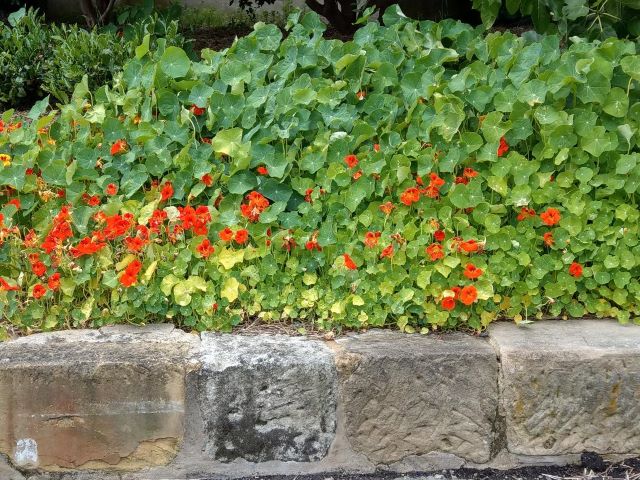
Nasturtium leaves and flowers are edible and can be harvested for use throughout the growing season. Young nasturtium leaves are more tender and flavorful. Nasturtium flowers make a lovely garnish or addition to a salad. And young nasturtium seeds are also edible and best when pickled.
You can read more about eating nasturtium, including pickling the seeds for capers, in our article Eating Nasturtium – Tips for Using Nasturtium in the Kitchen.
Flowers and leaves can be stored in plastics bags in the refrigerator but they are best eaten fresh if possible.
You can collect nasturtium seeds after they dry on the plant and store them in a paper envelope for planting in the following season. Storing in a cool and dry place to keep them fresh and viable. Or if you’re like me, just leave the nasturtium seed to drop where they are because nasturtium self-seeds easily. And next season, when the conditions are right, new nasturtium plants will come up all on their own.
Nasturtium Companion Planting
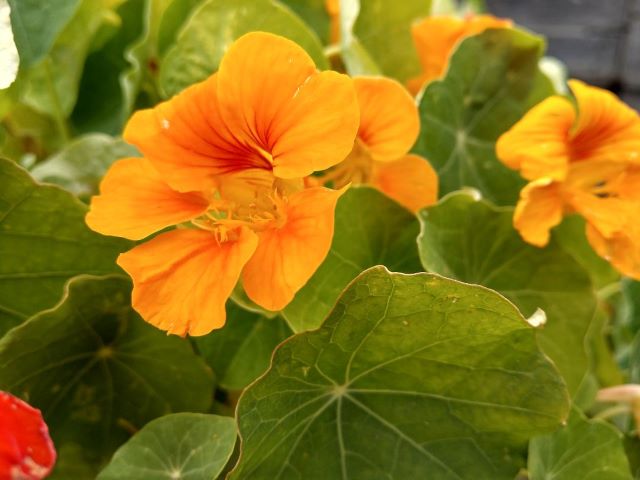
Companion planting is the process of planting plants together which can benefit each one in way or another. Nasturtiums make a great companion plant for vegetables. Growing nasturtiums in the vegetable garden act as a sacrificial plant. The nasturtium plant attracts aphids and other insect pests away from your more valued edible plants like beans and squashes.
Nasturtium also attracts beneficial insects to the garden such as bees and other pollinators who will work hard to pollinate the vegetable garden for you. They make great companions for cabbage, kale, broccoli, cauliflowers, radishes, squash, tomatoes, and melons.
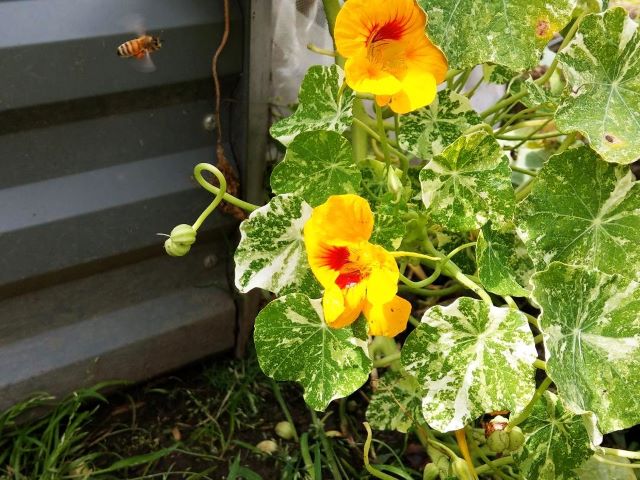
Conclusion
With so many varieties of nasturtiums to choose from, there is one to suit every garden. And not only do nasturtium plants provide beautiful color, but they also attract pollinators to your vegetable garden, keep garden pests under control as a companion plant and they are completely edible! With so many benefits, nasturtium plants truly a productive plant to grow.
Recommended Products:
- Nasturtium Seed – Jewel Mix
- Peat Pots – for seed raising
- Organic Seed Raising Soil
- Seedling Heat Mat
Some of My Favorite Gardening Products
- AeroGarden Bounty Indoor Hydroponic Herb Garden
- Heirloom Herb Seeds Set
- Haws Handy Plastic Indoor Watering Can
- Horticultural Neem Oil
Further Reading:
- Nasturtiums Dying? 5 Causes with Solutions!
- Growing Roses for Hips: Grow Guide for Edible Rose Hips
- How to Grow Turmeric and Make Your Own Turmeric Powder
- Growing Basil Tips: How To Grow Basil At Home
- How To Grow Ginger: Guide To Growing Ginger At Home
- How to Grow Lemongrass: Planting and Growing Guide
